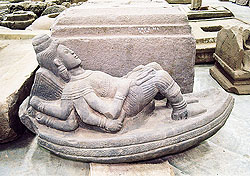

It's obvious by now that the placement of the temples in and around the greater Lingaparvata site are all aligned with the peak of the mountain. Oumong temple also exhibits it's front entranceas aligned directly with top of Lingaparvata which is viewable through the tops of the trees (fig. 11).
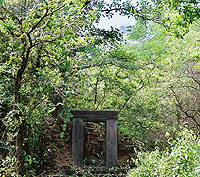
King Jayavarnman II installed two Shiva Lingas at Oumong and in 1973 Pierre Lintengre found a Sanskrit inscription on the front stairway relating the importance of the founding of the Khmer empire.
There can be little doubt that temple construction around Vat Phu was always orientated to Lingaparvata. Mollerup points out that Tham Lek cave is the focal point geometrically, astronomically, and is conceptually regarded as the hub of the universe. From this cave the sun can be seen rising behind Tomo on the winter solstice. Indian astronomy was very much a part of the conceptual design through out the entire ancient city complex as well as being symbolically represented in later temple construction.
Keeping in mind the works of Achar (2007) and Singh (2006), mentioned above, the people of the Indian sub-continent passed down an unbroken history of astronomical concepts from as early as 7000 BCE. In a study on pre-historic astronomy N. Rao (2005: 508) reports on megalithic astronomical sites (fig. 12) discovered in Hanamsagar, India ( Rao 2005: 508).
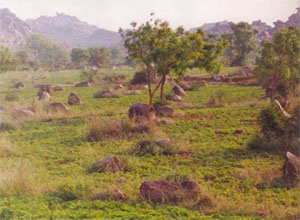
By monitoring sunrises over the horizon, site lines were arranged using a central point on a line of stones so that the winter solstice could be determined. Rao points out the observational aspects based on collected archaeological data. These megalithic observations were still in use when the ancient city of New Kuruksetra was founded, and the religious development from megalithic beliefs in the area has already been observed by Wales (1961: 202). In the 9th century large scale contributions were made to Vat Phu (Briggs 1951: 188-189). The artisans at this time carved many astronomical representations that emphasized the unique significance Vat Phu held for the kings who wanted to assure their divine connection with the gods. One of the best examples is the churning of the milky ocean (fig. 13.) placed over the southern entrance going into the main shrine.
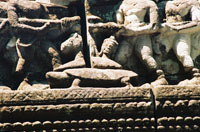
On close inspection of this badly damaged lintel are four asuras and four devas pulling on Vasuki's head and tail with Kurma (Vishnu's second incarnation) acting as a pivot for the world axis (skhambha). Most noteworthy are the two entities on Kurma's back one being the horse head of Uchchaih-sravas and the other the head of Lakshmi (Vishnu's consort). It is a most unusual configuration because the entire lintel is bordered by small orbs numbering 108. If we re-call the number of lotus columns on the 2nd stage of the axial causeway, numbering 54, we can recognize how the astronomical ratios were incorporated into temple construction. The astronomical references to 108 are far too numerous to mention here, but the most important is the numerical relationship between the earth, moon and sun. The number one hundred and eight is roughly the average distance between the sun and the earth in terms of solar diameters. It is also the average distance between the moon and earth in terms of lunar diameters (Kak 2001: 205).
These astronomical symbols of measurements were taken from the Vedas and incorporated at Vat Phu. The sun's equinoctial position aligning with the north and south walls of the ancient city, as well as recognizing the position of the winter solstice over Tomo, are indications that a cosmic center was recognized in the city of Shrestrapura and probably more so as the city became more populated during the early 6th century if not earlier. A recent excavation in the ancient city uncovered a portion of a mandapa which has the same design as ones found on the temples at Sambor Prei Kuk (Fig. 14.). These same designs were incorporated into the flying palaces/pavilions at Sambor (Siribhadra 2006).
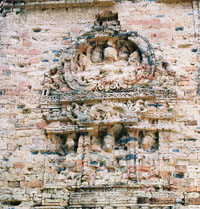
The history begins to be more understandable as more inscriptions are discovered around the ancient city of New Kuruksetra. Attention is now directed to the ancient Khmer king Mahendravarman. Both Sanskrit and Khmer inscriptions from Mahendravarman have been discovered and translated (Jacques 1993). An inscription found close to Wat Luang Kau near the ancient city is engraved on a pedestal bearing a statue of Nandin; the sacred bull of Siva (Jacques 1993). Jacques mentions that Mahendravarman moved to Sambor Prei Kuk. It is speculative why he did move to Sambor but if we look at the history of Sambor we know it became the next capital city and was more central to the administrative functions for an anticipated expansion of the empire. The "Temple of the Lord" was established at Sambor and much of what was learned by Mahendravarman at Vat Phu was assuredly communicated to his son and what followed was a new layout for all pre-Angkorean temples forming the new capital of Ishanapura. If Vat Phu was unique for its axial orientation, Sambor became unique for the construction of an octagonal temple (sanctuary 7) in honor of Vishnu and contained a circular pedestal which has recently been restored by a Japanese team from Waseda University in Japan (Kompheak et al. 2003). The deity with an equine head (Hayagriva) (fig. 15a.), which used to be on the pedestal, is now housed in the Guimet Museum in Paris, but another equine deity, which came from Kuk Trap (Kandal), Cambodia, (fig. 15b.) is housed at the National Museum Cambodia.
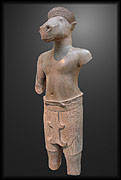
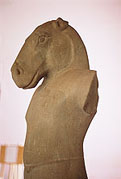
These same deities are known as Hayagriva in India and I see no reason not to equate the deities found in Cambodia to be the same as in India even though Jessup and Zephir find no conclusive evidence to identify which avatar the deities represent (Jessup and Zephir 2004; 46). I do not believe they represent Kalkin, the last incarnation of Vishnu, but are Hayagriva in keeping with all the other astronomical references. Hayagriva saved the Vedas after their theft from Vishnu who was sleeping on the universal waters. The Vedas were always going to be symbolically saved. This equine deity has gone virtually unnoticed in the literature of Cambodia. Saving the Vedas is one of the most powerful astronomical symbols in the Vedas because it's this myth that indicates the equinoctial point is shifting from Gemini to Taurus. It says in the Mahabharata, "Applying his (Vishnu) yoga-puissance, he assumed a second form. His body, equipped with an excellent nose, became as bright as the moon. He (Vishnu) assumed an equine head of great effulgence, which was the abode of the Vedas" MB(CCCXLVIII).
The horse is the most ancient of animal symbolism used in India. Surya, the sun god, took the form of a horse and begot two sons, the Ashvins (the twins) who are praised in the Rg-Veda (RV. 1, 3). It was the Ashvins who learned the secrets of immortality from the Rishi Dadhyank (RV. 1,116, 12) who with a horse's head spoke forth the sweet doctrine of the Vedas. This horse head which Vishnu assumed when he saved the Vedas came from Lake Sayranyvant at Kuruksetra the same place that is on the "center line to the universe" (Van De Bogart 2006). This relationship of the horse head in Kuruksetra India and the horse head shown at Vat Phu with the churning of the milky ocean and then in Sambor Prei Kuk at temple N7 (the older northern group) testifies to the fact that the cosmic center would be a part of New Kuruksetra and fully expressed at Sambor Pri Kuk.
The brick temples found at Sambor Prei Kuk are among the oldest pre-Angkorean examples of brick construction and many of them are still in very good condition. There is a circular opening (fig. 16.) at the top of the octagonal temple N7 (hypaethral), which clearly demonstrates a direct connection to the heavens. The axis of the universe is usually cylindrical or four or eight angled. The eye of Prajapati's crudest form, his cosmic body, is the sun. So with the axis of the universe symbolized as the octagonal temple with an opening at the top we can see Prajapati's eye looking to the heavens (Coomarswamy 1977:194).

 Next
Next